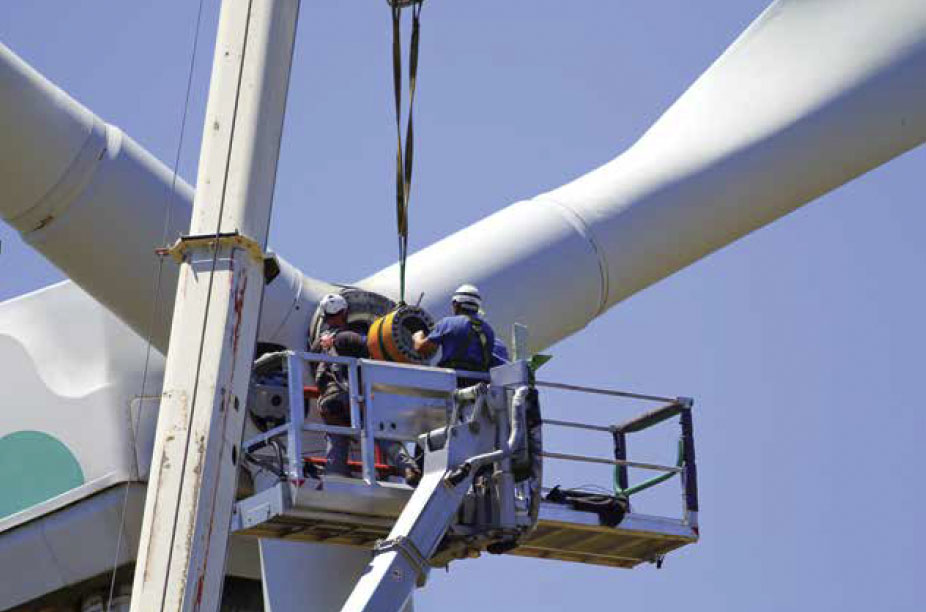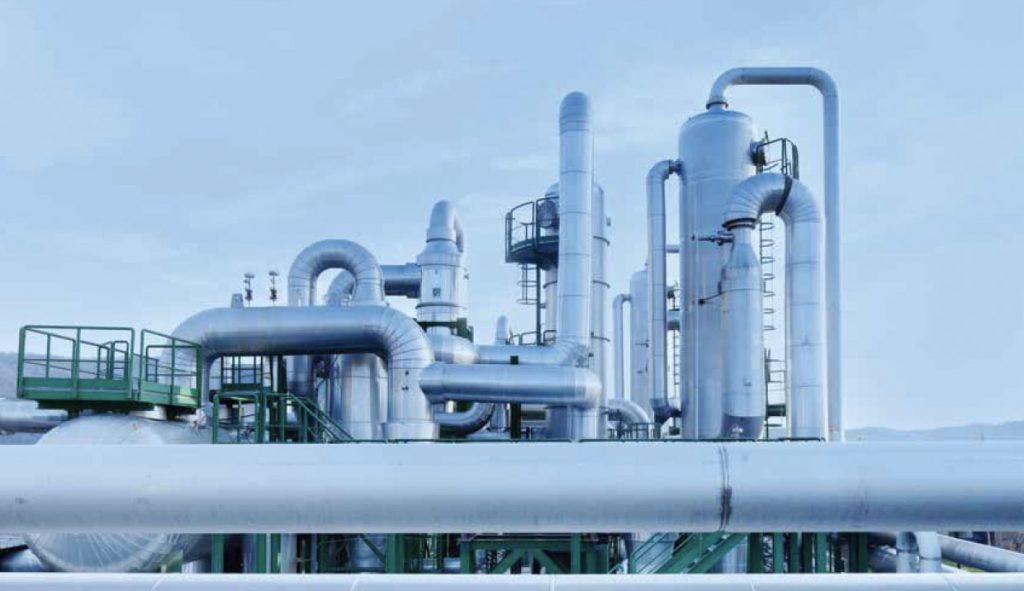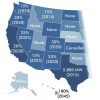The search for a jobs-positive shift to clean energy
Nearly 500 Wyoming coal miners were laid off last spring, and in the past two years roughly 5,400 oilfield workers lost their jobs in the state. In 2015, Wyoming saw the highest unemployment spike in the nation. Fossil fuel industries here support a whole host of related businesses that provide supply, repair, transportation, legal, accounting, and other services to mining operations. Those suffered dramatically, too. The subsequent drop in tax revenue led to a budget shortfall of roughly $150 million this past fiscal year and deep cuts to public services statewide.
 Wyoming at present is experiencing a grim case of déjà vu, thrust by low commodity prices into an economic slump after a decade of good times. Previous busts have been temporary, and workers needed only to wait until energy prices rebounded for the industries to right themselves and offer more jobs. But the current situation is prompting economists, government officials, and workers alike to wonder if we might be catching a glimpse of Wyoming’s future in a fossil fuel-free world.
Wyoming at present is experiencing a grim case of déjà vu, thrust by low commodity prices into an economic slump after a decade of good times. Previous busts have been temporary, and workers needed only to wait until energy prices rebounded for the industries to right themselves and offer more jobs. But the current situation is prompting economists, government officials, and workers alike to wonder if we might be catching a glimpse of Wyoming’s future in a fossil fuel-free world.
“This storm looks long, like a structural change, not just a cyclical downturn,” says Robert Godby, director of the Center for Energy Economics and Public Policy at the University of Wyoming.
Some in Wyoming look forward with hope to Donald Trump’s presidency, since he made sweeping promises about saving the coal industry. But market forces—not regulation—are largely responsible for the downturns in the oil, gas, and coal industries.
“If there’s any culprit in terms of coal’s woes right now, it’s natural gas, and has been since 2008,” says Godby. Fracking, which ramped up nationwide around 2008, enabled companies to overproduce and thus create a supply glut of oil and gas, deflating fossil fuel prices across the board and hitting coal particularly hard.
Regardless, Wyoming’s economy is famously homogenous. Mining—mostly for oil, gas, and coal—employs more than ten percent of the state’s total workforce at salaries far higher than the statewide average. A larger percentage of Wyoming’s population works in fossil fuels than does that of any other state. Wyoming’s second largest industry, tourism, offers mostly low-paying service jobs. Scattershot opportunities exist for laid-off miners in smaller local industries like construction, but options for good work are widely limited. It is easy to understand why, from the vantage of Wyoming, a world transitioning away from fossil fuels appears a foreboding landscape—one in which fossil fuel workers bear the brunt of a societal shift.
![]()
Amidst the debates over climate change taking place worldwide, voices calling for a “just transition” are becoming louder and more highly regarded. The notion of a “just transition” originated in the 1990s among labor groups whose members worked with toxic chemicals that government regulations were phasing out. It evolved in the era of global warming to describe a transition to renewable energy that does as little harm as possible to workers—in fossil fuel industries and otherwise.

Jeremy Brecher said climate activists and labor organizers are working more closely than ever to protect jobs and slow global warming at the same time. Brecher is the co-founder of the Labor Network for Sustainability, a coalition formed in 2009 whose notion of sustainability relates not only to climate change, but to employment and social justice as well. Brecher noted the International Association of Machinists, whose membership includes railroad workers who haul coal to West Coast seaports, passed a major resolution in September recognizing the union’s need to support climate action. In 2015, the International Trade Union Confederation, which represents more than 180 million workers in 162 countries, hosted a summit on global warming titled “No Jobs on a Dead Planet.” And even though national labor unions in the United States have been reluctant to support many measures to fight climate change because of a perceived jobs risk, activist stirrings among local chapters indicate a rank-and-file willingness to advocate for climate justice. For instance, although five of the country’s largest unions officially came out in favor of the Dakota Access Pipeline, in October a sizeable contingent of union workers set up camp alongside Native American water protectors on the Standing Rock reservation in North Dakota to help stop its construction.
“It just shows that people are becoming aware that this threat is so serious that we have to act on it, even if that makes some economic problems for us,” Brecher said. “But we have to address those economic problems, as well, and find a worker-friendly way to move to fossil-free energy.”
According to a Labor Network for Sustainability study, the switch to renewable energy has the potential to create hundreds of thousands of jobs nationwide, mostly in manufacturing and construction. An ideal “just transition” might fill these positions across the country with laid-off Wyoming miners.
“The overall effect [of a switch to renewable energy] is very jobs-positive—numerous other studies have come to the same conclusion,” Brecher said. “A lot of people who work in Western coal mines have the skills of construction workers, like the capacity to operate big machinery. There will be a lot of jobs in building the clean energy economy for people with those skills.”
But while some of those jobs already exist, most do not. And while some of them will exist in Wyoming, many will require displacement. Crews broke ground in September in the southern part of the state on what will be the largest wind farm in the world, but the construction will mostly be executed by specialists not likely from Wyoming or inclined to stick around after the wind farm is complete. The state did hardly anything to attract related industry that would provide high-paying jobs in the long term, such as turbine manufacturing. While building a renewable energy infrastructure will be jobs-positive on a national and global scale, little at this point indicates Wyoming will take advantage of the opportunity.

In the absence of readymade jobs to fill, Brecher said a support system should be put in place to buoy workers set adrift by climate policies. The best model, he said, is the GI Bill of Rights that helped soldiers returning from World War II re-enter the working world. Their benefits included access to a full education as well as low-interest home mortgages and business loans.
“We need something that makes that kind of boost available to anybody whose job is lost as a result of policies that are necessary for the future of the world,” he said.
![]()
Last year, as the coal industry buckled, President Obama unveiled the POWER Plus Program, which allocates money for struggling coal communities. It remains to be seen whether President Trump will push for federal funds to help these communities and workers, whose recovery looks difficult even without regulations. But Wyoming officials seem eager to find a market solution to fossil fuel’s woes, even if the market caused those woes in the first place.
Jeremiah Rieman, natural resources policy director for Wyoming Governor Matt Mead, scoffed at Obama’s programs. First, he argued, any measure to abandon coal would be “a troubling, shortsighted move”—a dig at Obama’s Clean Power Plan, which Trump has promised to scrap. Furthermore, Rieman said, Obama’s POWER Plus program is unfair to Wyoming because it relies in significant part on money the state’s coal operators have paid into the Abandoned Mine Lands Fund—allocations that would normally return directly to Wyoming. Instead, the lion’s share of POWER Plus money is slated to go to eastern and Appalachian states like Virginia and Kentucky, which are also facing a coal crunch.
“In the last POWER proposal I saw, very little would be available for Western states,” Rieman said. “At the same time Wyoming is being impacted by these [climate] proposals, there’s very little to suggest that we would benefit from the programs that are being put forward.”
Godby, the economist, said instead of using AML funds, the best way to financially support workers and communities impacted by climate policies would be a national carbon tax. Recent reports from the Brookings Institute note such a tax could, conservatively, generate up to $1 trillion in revenue in the span of a decade.
“The big benefit of a carbon tax is that it raises revenue to cover the transition costs of imposing regulation—to at least do something to offset some of those effects, whether it’s for training or economic development,” Godby said. “With any other approach—including the Clean Power Plan—you’re going to have to generate additional revenue somewhere else or reallocate expenditures to help the transition.”

Compared to the Clean Power Plan, which clocks in at 1,560 pages and requires massive amounts of centralized oversight, a carbon tax would be simple, transparent, and cheap to implement, Godby said. But imposing such a tax would require an act of Congress, and in this political climate, Godby said, “‘tax’ is a four-letter word. People hate taxes. We should probably start by renaming it. Maybe call it a ‘fee.’”
Rieman said coal is already considerably taxed, at an effective rate of 39 percent including royalties and fees, and if anything, taxes should be decreased because they’re overburdening the industry.
“It’s better to invest in miners and mining and continuing to mine and investing in technology as a solution, rather than taxing these resources out of use,” he said.
Elsewhere in the state government, members of the Wyoming Business Council are working to expand the economy beyond just mining. Touting the nation’s friendliest tax policies, the council’s ten-year plan calls for courting companies to expand five target industries: manufacturing, advanced conversion technology (clean coal), data centers, logistics and distribution (shipping), and lifestyle entrepreneurs (which the Northeast Wyoming Growth Alliance describes as “the telecommuter who works via wifi on her front porch; the fly-fishing guide who schedules appointments online; the potter or the writer who creates in a back-yard studio”). Spokesperson Ron Gullberg said the council is beefing up its outreach, redesigning its website to present a more attractive digital front end, and developing a “business ambassadors” program to generate leads. It recently entered into a partnership with XPRIZE, a $20 million global competition to find ways to transform carbon emissions into saleable products (the winner will be the first tenant of the new Wyoming Integrated Test Center, a new research hub studying “clean coal” technology).
“A lot of what might seem like little things are very important,” Gullberg said. “We’re getting our storytelling up there, getting word out about infrastructure and Wyoming’s business advantages—the low cost of doing business here, with no corporate or income taxes.”
One major tool for spurring development, however, has been lately diminished: state funds. The Wyoming Business Council relies heavily on its Business Ready Community Grant program to incentivize companies to choose Wyoming. In recent years, for instance, the council awarded farming technology upstart Bright AgroTech $2.85 million for a new headquarters, it granted tech firm UL $3.3 million for a new facility, and firearms accessories manufacturer HiViz received $2.9 million to relocate from Colorado. But statewide funding cuts did not spare the council. Its grant program was slashed roughly 30 percent from the prior biennium, down to $38.5 million for 2017–2018. Another $20 million pool the council used for one-time business funding was eliminated altogether.
Gullberg said the state-level belt-tightening made some members of the council eager to explore options for federal funding, like those available from Obama’s POWER program. Wyoming faces difficulties attracting businesses because it’s such a small market, not densely populated, and it competes with regional urban hubs like Denver and Salt Lake City that offer firms access to more economic activity. Being able to offer a company $3 million for shiny new headquarters definitely helps.
But Dave Spencer, director of the Wyoming Business Council’s northeast region, took one taste of Obama’s program and soured to it. After learning of POWER in 2015, Spencer and his colleagues in the region crafted a set of proposals for the Economic Development Agency, which oversees POWER funding. These included studies related to tourism, plastics manufacturing, and a research facility in the area’s small towns.
“We put together a bunch of projects, but the EDA kind of turned their nose up at them,” Spencer said. “Their requirements are so stringent that they’re really hard to work with, and we just didn’t feel like it was worth pursuing.”
Among the POWER plan’s requirements for funding is a local match—something the Wyoming Business Council would need to provide, since, Spencer said, “None of these communities have money for a match.”
But Spencer’s experience speaks to deeper divisions between the federal government and conservative, fossil fuel producing states. It suggests the movement for a “just transition” has a long way to go before everyone is convinced that a big pot of government money—whether it comes from AML funds, a carbon tax, or elsewhere—is going to provide a smooth ride to the New Energy Future.
“The state’s not in great shape financially, so any outside help we could get might be welcome,” Spencer said. “But our typical experience with using those kinds of funds on state projects is that it adds a level of complexity to the point that you wonder whether it was worth it or not. They’re not easy to work with. Maybe we’re just too independent out here or something.”
By Nathan C. Martin
Nathan C. Martin is a freelance writer from Wyoming.


